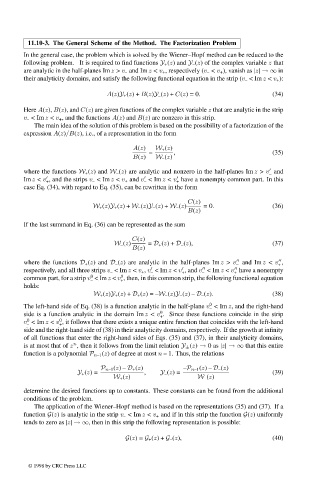Page 584 - Handbook Of Integral Equations
P. 584
11.10-3. The General Scheme of the Method. The Factorization Problem
In the general case, the problem which is solved by the Wiener–Hopf method can be reduced to the
following problem. It is required to find functions Y + (z) and Y – (z) of the complex variable z that
are analytic in the half-planes Im z > v – and Im z < v + , respectively (v – < v + ), vanish as |z| →∞ in
their analyticity domains, and satisfy the following functional equation in the strip (v – <Im z < v + ):
A(z)Y + (z)+ B(z)Y – (z)+ C(z) = 0. (34)
Here A(z), B(z), and C(z) are given functions of the complex variable z that are analytic in the strip
v – <Im z < v + , and the functions A(z) and B(z) are nonzero in this strip.
The main idea of the solution of this problem is based on the possibility of a factorization of the
expression A(z)/B(z), i.e., of a representation in the form
A(z) W + (z)
= , (35)
B(z) W – (z)
where the functions W + (z) and W – (z) are analytic and nonzero in the half-planes Im z > v and
–
Im z < v , and the strips v – <Im z < v + and v <Im z < v have a nonempty common part. In this
+
+
–
case Eq. (34), with regard to Eq. (35), can be rewritten in the form
C(z)
W + (z)Y + (z)+ W – (z)Y – (z)+ W – (z) = 0. (36)
B(z)
If the last summand in Eq. (36) can be represented as the sum
C(z)
W – (z) = D + (z)+ D – (z), (37)
B(z)
where the functions D + (z) and D – (z) are analytic in the half-planes Im z > v and Im z < v ,
+
–
respectively, and all three strips v – <Im z < v + , v <Im z < v , and v <Im z < v have a nonempty
–
+
+
–
0
0
common part, for a strip v <Im z < v , then, in this common strip, the following functional equation
–
+
holds:
W + (z)Y + (z)+ D + (z)= –W – (z)Y – (z) – D – (z). (38)
0
The left-hand side of Eq. (38) is a function analytic in the half-plane v <Im z, and the right-hand
–
0
side is a function analytic in the domain Im z < v . Since these functions coincide in the strip
+
0
0
v <Im z < v , it follows that there exists a unique entire function that coincides with the left-hand
+
–
side and the right-hand side of (38) in their analyticity domains, respectively. If the growth at infinity
of all functions that enter the right-hand sides of Eqs. (35) and (37), in their analyticity domains,
n
is at most that of z , then it follows from the limit relation Y ± (z) → 0as |z| →∞ that this entire
function is a polynomial P n–1 (z) of degree at most n – 1. Thus, the relations
P n–1 (z) – D + (z) –P n–1 (z) – D – (z)
Y + (z)= , Y – (z)= (39)
W + (z) W – (z)
determine the desired functions up to constants. These constants can be found from the additional
conditions of the problem.
The application of the Wiener–Hopf method is based on the representations (35) and (37). If a
function G(z) is analytic in the strip v – <Im z < v + and if in this strip the function G(z) uniformly
tends to zero as |z| →∞, then in this strip the following representation is possible:
G(z)= G + (z)+ G – (z), (40)
© 1998 by CRC Press LLC
© 1998 by CRC Press LLC
Page 567

